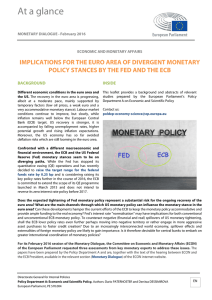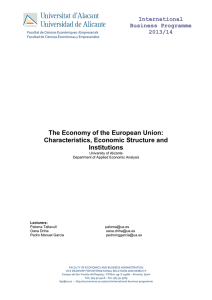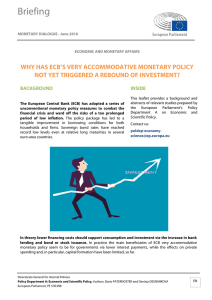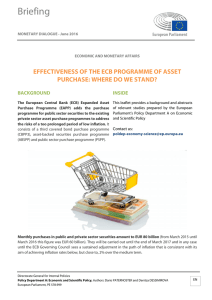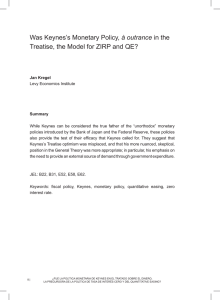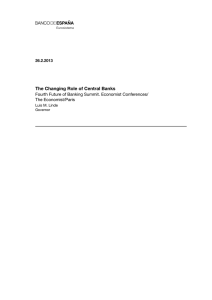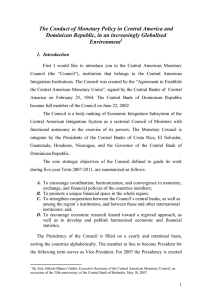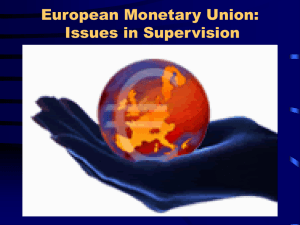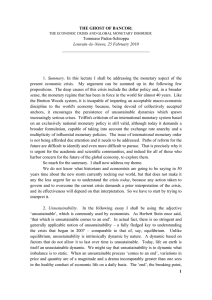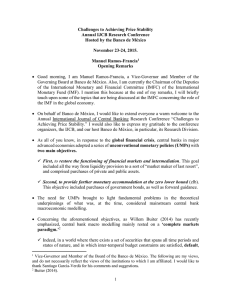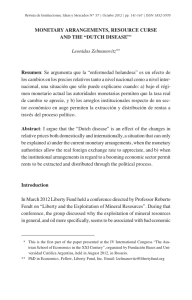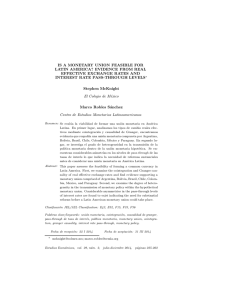Interaction between monetary policy and bank regulation
Anuncio
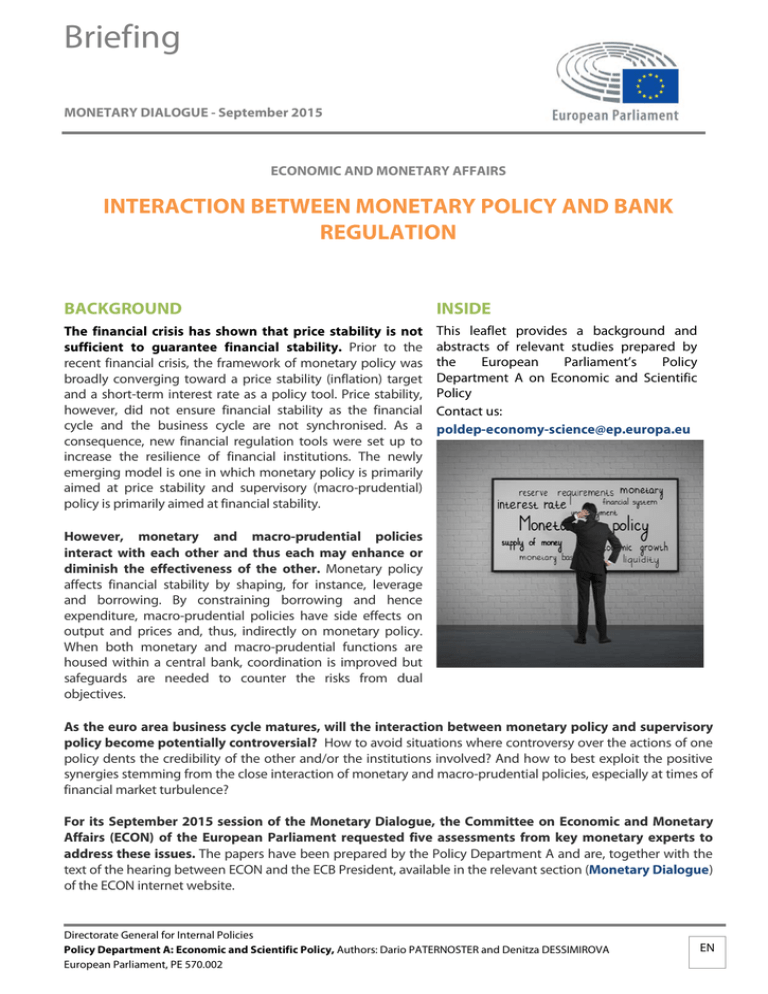
Briefing MONETARY DIALOGUE - September 2015 ECONOMIC AND MONETARY AFFAIRS INTERACTION BETWEEN MONETARY POLICY AND BANK REGULATION BACKGROUND INSIDE The financial crisis has shown that price stability is not sufficient to guarantee financial stability. Prior to the recent financial crisis, the framework of monetary policy was broadly converging toward a price stability (inflation) target and a short-term interest rate as a policy tool. Price stability, however, did not ensure financial stability as the financial cycle and the business cycle are not synchronised. As a consequence, new financial regulation tools were set up to increase the resilience of financial institutions. The newly emerging model is one in which monetary policy is primarily aimed at price stability and supervisory (macro-prudential) policy is primarily aimed at financial stability. This leaflet provides a background and abstracts of relevant studies prepared by the European Parliament’s Policy Department A on Economic and Scientific Policy Contact us: poldep-economy-science@ep.europa.eu However, monetary and macro-prudential policies interact with each other and thus each may enhance or diminish the effectiveness of the other. Monetary policy affects financial stability by shaping, for instance, leverage and borrowing. By constraining borrowing and hence expenditure, macro-prudential policies have side effects on output and prices and, thus, indirectly on monetary policy. When both monetary and macro-prudential functions are housed within a central bank, coordination is improved but safeguards are needed to counter the risks from dual objectives. As the euro area business cycle matures, will the interaction between monetary policy and supervisory policy become potentially controversial? How to avoid situations where controversy over the actions of one policy dents the credibility of the other and/or the institutions involved? And how to best exploit the positive synergies stemming from the close interaction of monetary and macro-prudential policies, especially at times of financial market turbulence? For its September 2015 session of the Monetary Dialogue, the Committee on Economic and Monetary Affairs (ECON) of the European Parliament requested five assessments from key monetary experts to address these issues. The papers have been prepared by the Policy Department A and are, together with the text of the hearing between ECON and the ECB President, available in the relevant section (Monetary Dialogue) of the ECON internet website. Directorate General for Internal Policies Policy Department A: Economic and Scientific Policy, Authors: Dario PATERNOSTER and Denitza DESSIMIROVA European Parliament, PE 570.002 EN Policy Department A: Economy and Scientific Policy PUBLICATIONS In-Depth Analysis on 'Macro-prudential policies and monetary policy: Three neglected issues' by Daniel Gros (Centre for European Policy Studies) Macro-prudential policy is taken to be a natural complement to monetary policy. The standard division of labour is that monetary policy sets the interest rate aiming at price stability whereas macro-prudential policy aims at ensuring financial stability. In reality, there might also be conflicts of interest. At the present time, it appears that the ECB seeks to stimulate more expenditure because it is undershooting its price-stability target. But the most solvent agents in the core countries do not respond, and more expenditure by the highly indebted agents in the euro area’s periphery is not desirable as it would delay the necessary deleveraging. In-Depth Analysis on 'The interaction between monetary policy and macro-prudential policies: challenges faced by ECB monetary policy in the current governance framework for financial regulation' by Angel Ubide, Senior Fellow (Peterson Institute for International Economics) One of the main lessons from the global financial crisis is that price stability is not sufficient to guarantee financial stability. The mandate of monetary policy is to ensure price stability in the real economy, and doesn’t include, and should not include, addressing potential instability in financial markets. Financial stability should be the remit of macro-prudential policy, with the objective of safeguarding the stability of the financial system and containing systemic risk. The ECB is very likely going to have to keep interest rates at zero for several years in order to fulfil its price stability mandate, and therefore it is critical its policy action is complemented by effective, pre-emptive and coordinated macro-prudential policies. However, the macroprudential framework of the euro area is fragile, especially on the borrower side, and its legal basis should be strengthened, especially within the Single Supervisory Mechanism area. In-Depth Analysis on 'Interaction between monetary policy and bank regulation' by Marek Dabrowski (Center for Social and Economic Research) The ECB recently became engaged in macro-prudential policies and the micro-prudential supervision of the largest euro area banks. These new tasks should help complete financial integration, and make the euro area more resilient to financial instability risks. However, the multiplicity of mandates and instruments involves a risk of their inconsistency which could compromise the ECB’s core price-stability mandate as well as its independence. The experience of central banks during the recent global financial crisis confirms that such risks are not purely hypothetical. In-Depth Analysis on 'Interaction between monetary policy and bank regulation: Theory and European practice' by Eddie Gerba and Corrado Macchiarelli London School of Economics) The European Union has pursued a number of initiatives to create a safer and sounder financial sector for the single market. In parallel, bold unconventional monetary policies have been implemented in order to combat low inflation, foster risk taking and, ultimately, reinvigorate growth. But monetary and macro-prudential policies interact with each other and thus may enhance or diminish the effectiveness of the other. Monetary policy affects financial stability by shaping, for instance, leverage and borrowing. Equally, macro-prudential policies constrain borrowing, which in turn have side effects on output and prices, and therefore on monetary policy. When both monetary and macro-prudential functions are housed within the central bank, coordination is improved, but safeguards are needed to counter the risks from dual objectives. Against this background, this paper outlines the theoretical and empirical underpinnings of macro-prudential policy, and discusses the way it interacts with monetary policy. It identifies advantages as well as risks from cooperating in the two policy areas, and provide suggestions in terms of institutional design on how to contain those risks. Against this backdrop, the author evaluates the recent European practice. Disclaimer The content of this document is the sole responsibility of the author and any opinions expressed therein do not necessarily represent the official position of the European Parliament. It is addressed to the Members and staff of the EP for their parliamentary work. Reproduction and translation for non-commercial purposes are authorised, provided the source is acknowledged and the European Parliament is given prior notice and sent a copy. Policy Department A: Economy and Scientific Policy In-Depth Analysis on 'Interaction between monetary policy and bank regulation' by Rosa M. Lastra, Queen Mary (University of London) and Charles Goodhart (London School of Economics and Political Science) The expansion of the central bank’s objectives and instruments in the pursuit of financial stability, with greater powers over both macro-prudential policy and micro-prudential supervision has led to a major increase in central bank powers, raising important issues in terms of the coordination of different functions and the design of adequate accountability mechanisms. This paper explores the institutional and governance issues related to the interaction between monetary policy and banking supervision in the light of the establishment of the Single Supervisory Mechanism (with the ECB at the helm) and considers the new macroprudential function and its interaction both with micro-prudential supervision and with monetary policy (considering the range of conventional and non-conventional instruments adopted by the ECB since 2007). Financial stability considerations permeate throughout the paper. February 2016 Policy Department A: Economy and Scientific Policy POLICY DEPARTMENTS MONTHLY HIGHLIGHTS The five policy departments are responsible for providing both in-house and external - high-level independent expertise, analysis and policy advice at the request of committees and other parliamentary bodies. They are closely involved in the work of committees which they support in shaping legislation on and exercising democratic scrutiny over EU policies. Policy departments deliver policy analysis in a wide variety of formats, ranging from studies and in-depth analyses to briefings and the Fact Sheets on the EU. This written output serves a variety of purposes by feeding directly into the legislative work of a specific committee or serving as a briefing for delegations of members. The Monthly highlights provide an overview, at a glance, of the on-going work of the policy departments, including a selection of the latest and forthcoming publications, and a list of future events. To receive this publication send an email to: Ep-policydepartments@ep.europa.eu CONTACTS Policy Department A: Economic and Scientific Policy ECON - ENVI - EMPL - IMCO - ITRE - TAXE poldep-economy-science@ep.europa.eu SUPPORTING ANALYSES Access all Studies, In-depth analyses, Briefings and At a glance notes produced by the Policy Departments. All publications: www.europarl.europa.eu/supportinganalyses Disclaimer: The content of this document is the sole responsibility of the author and any opinions expressed therein do not necessarily represent the official position of the European Parliament. It is addressed to the Members and staff of the EP for their parliamentary work. Reproduction and translation for non-commercial purposes are authorised, provided the source is acknowledged and the European Parliament is given prior notice and sent a copy. © European Union, 2016
